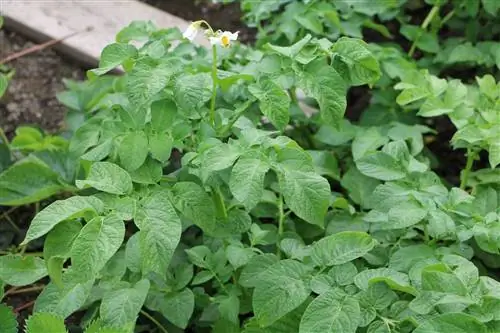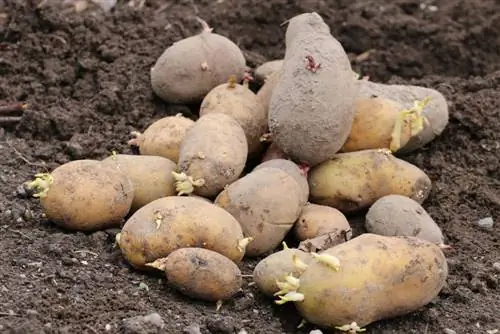- Author admin [email protected].
- Public 2023-12-17 03:39.
- Last modified 2025-01-24 12:45.
The potato is part of the daily menu in Central Europe and is therefore one of the most important staple foods. Many people also know it as a potato or grumberry. Like peppers and tomatoes, it belongs to the nightshade family. It thrives particularly well in countries with a temperate climate.
Originally, English sailors and Spanish conquerors brought the potato to Europe. The plant was initially mistakenly thought to be just an ornamental herb and was therefore only grown to beautify gardens. Later, around the 17th century, the aristocratic classes first discovered the potato as a food. However, their triumph in Europe began during the Thirty Years' War, when there was hardly any food.
Cultivation and cultivation
Most potato varieties are perennial plants. However, due to the alternating cultivation of the fields, it is only spread once a year. The main part of the potato plant develops underground. The so-called sprout tuber plays a key role. It is these parts that develop underground that become edible for humans. Everything that the potato forms above the ground has a toxic effect, as the poisonous alkaloid solanine forms in the parts.
Contrary to all conventional wisdom, the potato is a very maintenance-intensive plant. Due to their enormous need for light, I have to constantly remove weeds. The plant also needs a lot of space and even more time to be able to produce enough green weeds above ground. By using photosynthesis, the potato receives important nutrients, which it immediately stores in the fruits lying underground.
Before sowing, you should definitely make sure not to plant seed potatoes and tomatoes too close together. This is intended to prevent the transmission of plant diseases.
Potatoes are sown using so-called seed potatoes. It should be noted that the corresponding potato must contain at least one eye. These must be covered with enough soil, about 10 centimeters, to ensure optimal growth. The side that contains the most eyes is placed on top. The optimal growing temperature for seed potatoes is 15 to 18 degrees Celsius. Potatoes also need a lot of light, even if they still thrive underground in the first phase of growth. They should therefore be planted in preferably sunny locations. Potato plants are always grown in rows; a minimum distance of 30 centimeters should be maintained. This is the only way to guarantee that the plant has enough space for the underground fruits to grow.
Potatoes can be grown in the greenhouse from the beginning of March. The optimal planting time for the ever-popular early potatoes is mid-April. All other varieties should be put in the ground from the end of April to around mid-May. The harvest time for early potatoes is when the first green of the above-ground part of the plant is already in bloom. The rule of thumb for all other types of potatoes is that they are only harvested once the green of the plant has yellowed. Depending on the sowing, this can be the case from the end of July to the end of October. It is important to note that potatoes should under no circumstances be exposed to frost or extreme cold. This applies to the growing period as well as to subsequent storage. Potatoes react sensitively to temperatures that are too low and then taste very sweet.
Once the first tender shoots have formed above ground, you should regularly loosen and pile up the soil around the plant. Care must be taken not to damage the potato plant. Regularly piling up the soil ensures that not a single tuber comes out of the soil and becomes inedible. The potato is also not without water consumption. Since it consists largely of starch and water, it has to absorb a lot of moisture during its growth phase. It is therefore important to water the plants manually immediately in dry conditions. The plant often thanks you for this with a high yield of developed fruits.
Fertilization
When it comes to fertilization, potato plants are strong and grateful customers. They have a very high fertilizer requirement. It is therefore recommended to prepare the bed for potato sowing in autumn. Compost and stone dust can be used. These two substances are often enough to prepare the soil for the potato.
Diseases
The potato also has a lot to offer when it comes to diseases. The greatest danger here comes from so-called tuber or late blight. This is also commonly referred to as potato powdery mildew because it can be recognized by the milky discoloration on the plant's greenery. This disease is a fungus that often affects the entire plant in a very short time. The situation is similar with potato scab, another type of fungal infection. However, this infestation is less devastating. When it comes to pests, the North American Colorado potato beetle represents the greatest threat to the plant. For this reason, you should regularly check your potato plants for infestations and remove the animals from the plant or treat the foliage with algae lime. Other pests can include various species of fleas and louses and ants.
Storage
Potatoes should always be stored in dark, dry and cool places. Dark and dry basement rooms are ideal for this. Ideally, they are only exposed to green light, which inhibits the growth of eye germs and the potatoes last longer.
Extended Use
Due to their very high starch content, potatoes are often the raw material for various products, such as vodka. It is also used in the area of livestock feed preparation.
Varieties and care tips
There are many different types of potatoes, all of which have different requirements. So if you have decided to grow your own potatoes in your own garden in the future and now want to set out to buy seed potatoes (or seed potatoes), it is good if you know exactly the location and the nature of the soil.
The difference between normal potatoes and seed potatoes lies in the way they are treated. Since seed potatoes are exclusively potatoes for planting and not for consumption, they are stored immediately after harvest in such a way that they do not sprout. As a result, they develop a higher germination capacity, which then leads to the desired reproduction when planted. A seed potato is essentially the seed for table potatoes. Seed potatoes are controlled very strictly.
You should also have an idea of when you want to harvest the potatoes. A distinction is made here between early potatoes, very early, medium early, medium late, late and late potatoes. It is also important what the seed potatoes are needed for. There are table potatoes and commercial potatoes that are used, for example, in the production of animal feed. And last but not least, your own preferences for properties such as waxy or floury play a role in the decision.
Once you have bought the right seed potatoes, it is recommended to let them grow in a bright room that is around 10 to 15 degrees warm in order to stimulate their readiness to grow. Seed potatoes planted in March can often be harvested in June.
When is the best time to plant the seed potato in the ground cannot be answered clearly. Many facts play a role in this. For example, the climate, the nature of the soil and its preparation and whether the seed potatoes were pre-germinated or not. The core period is generally April and May, depending on weather conditions and variety. It is best if you get a planting recommendation when purchasing.
Potatoes need a breathable, water- and heat-permeable soil. This must consist of fine crumbs without any stones. It is best to add sand to the soil so that it can meet all of the above requirements. Potatoes require a lot of space. They should therefore be grown in a contiguous area.






